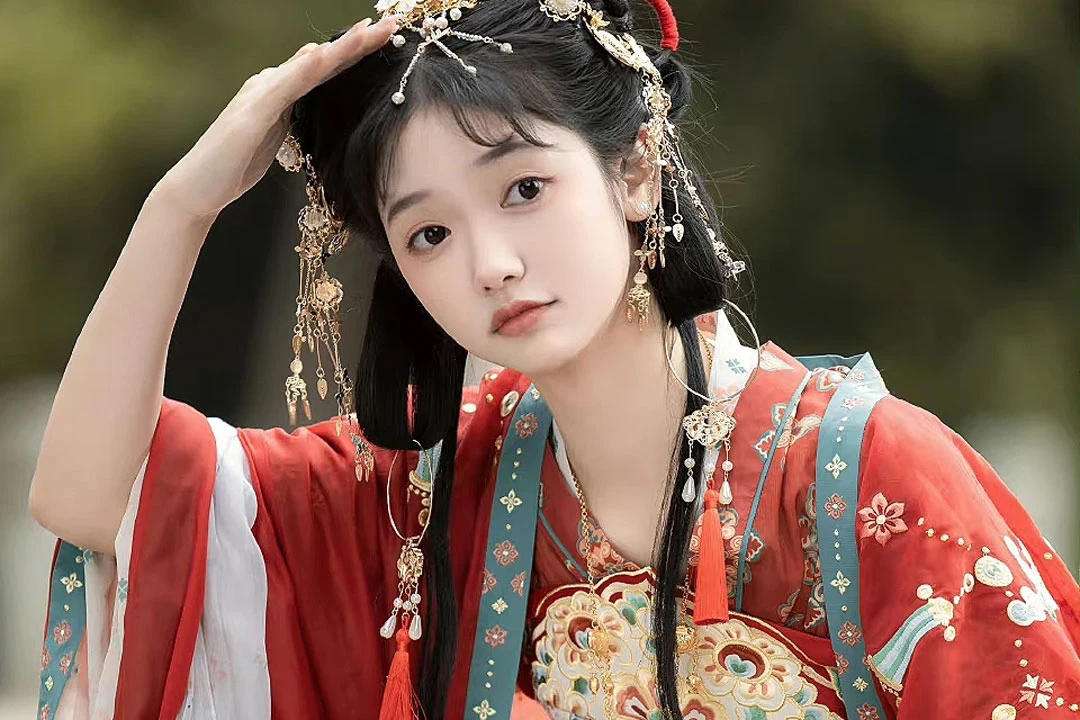In the annals of ancient Chinese history, the Han Dynasty stands as a testament to the sophisticated evolution of cosmetic practices. From emperors to commoners, the people of the Han Dynasty embraced a rich tapestry of makeup artistry that marked a significant transition from the simplicity of the past to the vibrant era of colorful expressions.
Powder White and Ink Black
Embracing the aesthetic of “powder white” and “ink black,” Han Dynasty citizens utilized natural ingredients for makeup due to various constraints. Ground rice served as a healthy yet subtly effective foundation, while lead-based powders, despite their toxicity, became popular for their remarkable whitening effects.
With the introduction of “Yanzhi” (rouge), the Han Dynasty boldly ventured into the realm of vibrant red makeup. Termed “Yonglai Zhuang” or “lazy-looking makeup,” this style involved not only powder application but also the use of vermilion. Thinly drawn eyebrows, and slightly curled and fluffy hair, conveyed a sense of languor and weariness. Surprisingly, even many men delighted in the application of rouge.
Intricate Eyebrows
Stone ink, widely used during the Han Dynasty, played a crucial role in creating the perfect eyebrows. By dissolving “Dai” (a black mineral) in water, an ink-like substance was produced, used to delicately draw eyebrows. From the renowned “Yuanshan Mei” (distant mountain eyebrows) to the “Changmei” (long eyebrows), this period witnessed the pinnacle of eyebrow fashion, introducing styles like the “Ba Zi Mei” and “Jing Cui Mei.”
Scarlet Lips and the Art of “Biting Lip Makeup”
The famed “Zhusha” (cinnabar) became the cosmetic of choice for lip coloring, creating a luscious red allure. The Western Han period distinguished itself with the unique “Biting Lip Makeup” trend. Initially, lips were powdered to match the skin’s tone, followed by the drawing of new lip shapes. This innovative technique allowed for the illusion of thinner or smaller lips, catering to different facial features.
Philosophical Shifts and Changing Beauty Ideals
The Western Han Emperor Wu implemented a policy favoring Confucianism, which, in turn, influenced societal perceptions of gender roles. Dong Zhongshu’s doctrines, including “Yang is superior, Yin is inferior,” and the “Three Bonds, Five Virtues,” laid the foundation for the dependence of women on men. Consequently, female beauty ideals transitioned from the Western Han’s subtle elegance to the Eastern Han’s delicate and submissive charm.
Tearful Beauty
The Han Dynasty saw the emergence of “Bai Zhuang” (white makeup), where women applied powders without rouge, giving their faces a pure and simple appearance. The popular “Tears Makeup” style, attributed to Sun Shou, the wife of the powerful Eastern Han minister Liang Ji, featured downturned eyes with a perpetual teary effect. The “Duo Ma Ji” hairstyle, resembling a loose and disheveled bun, and the “Zhe Yao Bu” walking style, characterized by a slightly hunched posture, complemented this unique makeup trend.
To enhance their allure, Han Dynasty women adopted the use of “Mian Ye” (facial dimples). Originally marking menstrual cycles, these facial dimples became popular as makeup, further accentuating beauty. The addition of “Hua Dian” or flower ornaments, delicate decorations crafted from colored paper, mica, and gold leaf, adorned women’s faces with an array of vibrant shapes, such as circles, leaves, peaches, and plum blossoms.
Sumptuous Headgear for Aristocratic Women
Noble women in the Han Dynasty adorned themselves with exquisite headgear, including “Ji Zan,” “Chai,” “Hua Sheng,” and “Bu Yao.” “Ji Zan,” particularly, played a vital role in securing elaborate hairstyles. As described in the “Later Han Book,” the empresses and queens of the Han Dynasty wore a “Ji Zan” made of one-foot-long tortoiseshell, exemplifying the opulence of their attire.
As we delve into the rich history of makeup in the Han Dynasty, it becomes evident that the cosmetic practices of this era were far more than mere embellishments. They were a reflection of societal values, philosophical shifts, and the timeless pursuit of beauty that continues to captivate us today.
The Impact of Hanfu on Makeup Styles
Hanfu influenced makeup trends in its own right. The flowing sleeves of Hanfu, for instance, encouraged the use of hand ornaments and finger makeup, adding an extra layer of elegance to the overall appearance. The intricate patterns and vibrant colors of Hanfu also inspired complementary makeup choices, creating a harmonious and visually stunning ensemble.
Moreover, the hairstyles of Hanfu wearers were often adorned with traditional hairpieces like “Ji Zan” and “Hua Sheng,” seamlessly integrating with the elaborate headdresses of the time. The overall effect was a stunning fusion of makeup and attire, showcasing the artistic sensibilities of the Han people.
In conclusion, the beauty standards of the Han Dynasty were not confined to makeup alone. Hanfu, with its timeless elegance, played an integral role in shaping the overall aesthetic of the era. Together, makeup and attire became a powerful expression of cultural identity, social status, and the enduring pursuit of beauty in ancient China.


